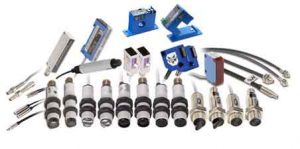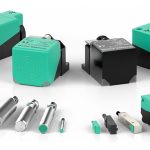 A sensor also known as detector is a converter that measures a physical quantity and converts it into a signal which can be read by an observer or by an electronic instrument. For accuracy, most sensors are calibrated against known standards.
A sensor also known as detector is a converter that measures a physical quantity and converts it into a signal which can be read by an observer or by an electronic instrument. For accuracy, most sensors are calibrated against known standards.
A sensor is a device which receives and responds to a signal when touched. A sensor’s sensitivity indicates how much the sensor’s output changes when the measured quantity changes. Sensors that measure very small changes must have very high sensitivities. Sensors need to be designed to have a small effect on what is measured; making the sensor smaller often improves this and may introduce other advantages. Technological progress allows more and more sensors to be manufactured on a microscopic scale as micro-sensors using MEMS technology. In most cases, a micro-sensor reaches a significantly higher speed and sensitivity compared with macroscopic approaches.
Age Old Sensor Devices
The most common are the Temperature Sensors which collects information about temperature from a source and converts into a form that is understandable by other device or person. The best illustration of a temperature sensor is mercury in glass thermometer. The mercury in the glass expands and contracts depending on the alterations in temperature. The outside temperature is the source element for the temperature measurement. The position of the mercury is observed by the viewer to measure the temperature.
IR Sensor which emits and/or detects infrared radiation to sense a particular phase in the environment. Generally, thermal radiation is emitted by all the objects in the infrared spectrum. The infrared sensor detects this type of radiation which is not visible to human eye.
UV sensors measure the intensity or power of the ultraviolet radiation. This form of electromagnetic radiation has wavelengths longer than x-rays but is still shorter than visible radiation. An active material known as polycrystalline diamond is being used for reliable ultraviolet sensing. UV sensors can discover the exposure of environment to ultraviolet radiation.
Touch sensor which acts as a variable resistor as per the location where it is touched. Generally, softwares are interfaced to the touch sensors. In such a case, a memory is being offered by the software. They can memorize the ‘last touched position’ when the sensor is deactivated. They can memorize the ‘first touched position’ once the sensor gets activated and understand all the values related to it.
Proximity sensor detects the presence of objects that are nearly placed without any point of contact. Since there is no contact between the sensors and sensed object and lack of mechanical parts, these sensors have long functional life and high reliability. The different types of proximity sensors are Inductive Proximity sensors, Capacitive Proximity sensors, Ultrasonic proximity sensors, photoelectric sensors, Hall-effect sensors, etc. A proximity sensor emits an electromagnetic or electrostatic field or a beam of electromagnetic radiation (such as infrared), and waits for the return signal or changes in the field. The object which is being sensed is known as the proximity sensor’s target.
Sensor Technology
One of the most important advanced and common sensor technology is Bar-code Identification. The products sold in the markets have a Universal Product Code (UPC) which is a 12 digit code. Five of the numbers signify the manufacturer and other five signify the product. The first six digits are represented by code as light and dark bars. The first digit signifies the type of number system and the second digit which is parity signifies the accuracy of the reading. The remaining six digits are represented by code as dark and light bars reversing the order of the first six digits. The bar code reader can manage different bar code standards even without having the knowledge of the standard code. Electromagnetic Identification of Manufactured Components is similar to the bar code technology where the data can be coded on magnetic stripe. With magnetic striping, the data can be read even if the code is concealed with grease or dirt.
Another important sensor device is Transponder which is related to automobiles. In the automobile section, Radio frequency device is used in many cases. The transponders are hidden inside the plastic head of the key which is not visible to anyone. The key is inserted in the ignition lock cylinder. As you turn the key, the computer transmits a radio signal to the transponder. The computer will not let the engine to ignite until the transponder responds to the signal. These transponders are energized by the radio signals.
Surface Acoustic Waves is similar to the RF identification. Here, the part identification gets triggered by the radar type signals and is transmitted over long distances as compared to the RF systems.
Optical Character Recognition is a type of automatic identification technique which uses alphanumeric characters as the source of information. In United States, Optical character recognition is used in mail processing centres. They are also used in vision systems and voice recognition systems.
Companies offering sensor products worldwide.
Pepperl+Fuchs offers a wide range of photoelectric sensors, fiber optic cables, & accessories. The chemical, pharmaceutical and petrochemical industries rely on Pepperl+Fuchs.
Colibrys is a world-leading supplier of standard and customised MEMS-based high end motion sensors for high precision and high reliability applications in harsh environments (Military, Aerospace and Energy) and safety critical (Industrial and Instrumentation) applications.
Galltec + Mela offers measurement and control instruments for humidity and temperature for a wide range of applications: hygrostats and sensors with the classic Polyga® humidity measuring element, or sensors with the capacitive Mela® sensor element, sensors with a digital Plug-and-Measure-Unit which can be directly calibrated, controllers and accessories.
With its special know how Accurate Sensors Technologies (AST ) & True Temperature Technologies (3T) has brought to the market a line of pyrometers suitable for high accurate temperature measurement in Aluminum and other non ferrous Industry. AST/3T Multi wavelength special pyrometers are pioneers in world market for Aluminum Industry.
Innovative Sensor Technology IST-AG, is the world-leading manufacturer of IST-AG PT 100/1000 and Nickel Sensors, Digital Temperature Sensors (TS IC’s), RH Sensors, Flow Sensors, Conductivity Sensors.
Sensor Technology Ltd is a manufacturer and supplier of TORQSENSE & LOADSENSE sensors and transducers. TorqSense is the worlds first low cost non-contact rotary torque transducers and LoadSense is a range of wireless load transducers.
New Entrants in Sensor Technology
Phenospex PlantEye is a new commercial 3D sensor platform and crop management system for automated plant screening and plant phenotyping. It is highly flexible and can be integrated into research or screening processes easily. PlantEye follows the “Moving-Sensor-Concept and it is designed for the use in climate chambers, greenhouses and fields. This enables measurements of individual plants, small trial plots or entire fields. The software comprises a MySQL database, which can be synchronized with climate computers or external sensors. The complete system is operating wireless and can be integrated easily in preexisting facilities or setups.
NDC Infrared Engineering has launched an improved PowderVision sampling system, that allows moisture to be measured in powders, granules and flakes flowing in enclosed ducts or gravity fed conveying systems. The sampling solution can be used with a wide range of industrial powders, including chemicals, minerals, detergents and ceramics.
For temperature sensors, Micro-Epsilon has launched a new Non-Contact Infrared Temperature Sensor that utilises a small sensor head with the electronics fully integrated into the sensor cable, making it suitable for use in installations where space is at a premium. The is available in four models, covering a temperature range from -20°C to +1030°C and can withstand ambient temperatures up to 120°C without the need for additional cooling.
In the field of fluid sensor devices, Molex Incorporated has introduced Customised Capacitive Fluid-Level Sensors, a low-cost measuring solution featuring disposable sensors and reusable electronic circuitry.
Designed for measuring fluid or granular material in non-metallic containers, the sensor electrode design and configurable software are said to provide higher accuracy with lower hardware cost and easier installation.
Banner Engineering has introduced the first Self-Contained Wireless Photoelectric Sensing Solution for multiple monitoring and control applications. A variety of sensing modes are available in this self-contained wireless series, allowing for functions such as presence/absence, alignment, position, counting, monitoring and detection. Battery life is up to five years, depending on model and application, and the housing is IP67/NEMA 6 rated.
To measure the accurate absolute and gauge pressure in gases, streams or liquids and to meet the needs of the food, beverage and life science industries Cerabar M family has launched Cerabar M PMC51 and PMP51 Hygienic Pressure Transmitters.
These are few of the latest technological developments that have taken place in this industry. With new advancements coming up every minute and sec, there is always a room for a new sensor, sensing device to rule the market.

